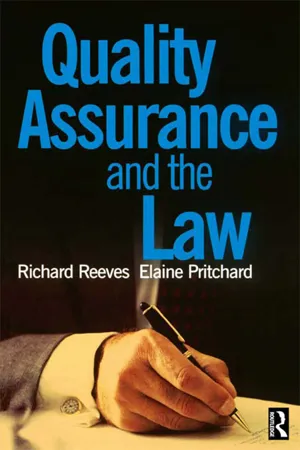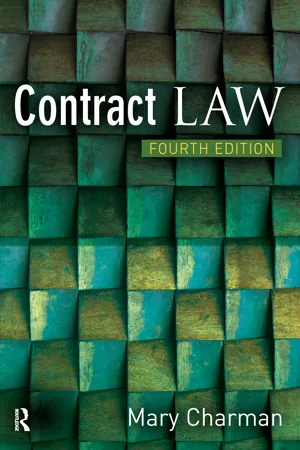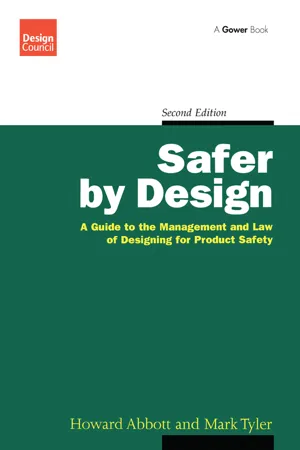Technology & Engineering
Consumer Protection Act 1987
The Consumer Protection Act 1987 is a UK law that provides protection to consumers in the event of product defects. It holds manufacturers, suppliers, and retailers responsible for ensuring that their products are safe for consumers to use. The act also allows consumers to seek compensation for damages caused by defective products.
Written by Perlego with AI-assistance
Related key terms
4 Key excerpts on "Consumer Protection Act 1987"
- eBook - ePub
- V.H. Harpwood(Author)
- 2009(Publication Date)
- Routledge-Cavendish(Publisher)
Any person in the chain of manufacture and distribution is potentially fully liable without proof of fault for any damage which is caused, wholly or partly, by the product.Liability is joint and several, which means that consumers have the option of suing all or any of the potential defendants. This overcomes many of the problems previously experienced by victims who were unable at common law to find or identify the defendant, particularly if that person or company had ceased to trade. Obvious targets for legal action under the Consumer Protection Act 1987 are the manufacturers or any person in the chain with good insurance cover, ‘deep pockets’ and the ability to pay substantial damages.15.4.3 Definition of a product
A ‘product’ is defined in s 2(1) of the Consumer Protection Act 1987 as:…any goods or electricity and (subject to subsection (3)) includes a product which is comprised in another product, whether by virtue of being a component part, raw material or otherwise.Goods are defined in s 45(1) as:…substances, growing crops, and things comprised in land by virtue of being attached to it and any ship, aircraft or vehicle.Damage which is caused by a break in the supply rather than a defect in the generation of electricity is not covered.The scope of this definition is not clear, and it remains to be seen whether it will be interpreted to include such things as computer programs which have been held to be ‘goods’ in another context (see St Albans CC v International Computers [1996] 4 All ER 481).Buildings as ‘immovables’ are not included in the definition, but building materials are, though defects in design and construction are not. Thus, if a part of a building collapsed through defects in the materials used, this could fall within the Consumer Protection Act 1987.Primary (unprocessed) agricultural produce and game was specifically excluded from the ambit of the Consumer Protection Act 1987. If it had undergone an industrial process to give it its essential characteristics, the produce was no longer ‘primary’ agricultural produce. This raised difficult questions as to what constitutes the industrial processing of agricultural produce. Clearly, eggs in their unchanged state were excluded, but if they were broken and mixed with other ingredients to make mayonnaise on a large or small scale, they probably fell within the Consumer Protection Act 1987 and there would be strict liability if they proved to be infected with salmonella. - eBook - ePub
- Elaine Pritchard, Richard Reeves(Authors)
- 2013(Publication Date)
- Routledge(Publisher)
Application of that section can be demonstrated by the following example. If (A) buys a new car, which unknown to him at the time, has a defective gear-box he would be able to hold both the car dealer (B) and the manufacturer of the defective gear-box liable for any injuries sustained as a result of the defect. If action was taken against (B) under the provisions of this section (B) would be able to escape liability by identifying the person who supplied him with the car. The identification of the manufacturer is not necessary. Again the importance of accurate record keeping cannot be over-emphasized. Persons who may be so affected should ensure records are kept of the suppliers of:1 the finished products,2 component parts, and3 raw materials and all dates of distribution or supply.The Consumer Protection Act 1987 – Part 2
Part 1 of the Act is concerned with civil liability and gives the injured party the right to sue one or more possible defendants, ensuring that persons suffering from personal injuries or damage to private property caused by a defective product will be compensated for their loss. The aim of Part 2 of the Act in particular was to prevent defective goods from reaching the market place in the first place. Section 10 of the Act which was concerned with the General Safety Requirement (GSR) has now been disapplied by the General Product Safety Regulations 1994. The remaining provisions of the Consumer Protection Act 1987 regarding the power to make safety regulations and issue notices is unaffected.For the most part it will be the safety requirement aspects of Part 2 which will give rise to the most immediate concern from the point of view of the quality of a product or service. As already stated, section 10 of the Consumer Protection Act 1987 was disapplied by the General Product Safety Regulations 1994, details of which can be found towards the end of this chapter.The Consumer Protection Act 1987 – Part 3
Whilst Parts 1 and 2 - eBook - ePub
- Mary Charman(Author)
- 2013(Publication Date)
- Willan(Publisher)
Liability under this Act arose when a watch was described as ‘waterproof’ and a ‘diver’s watch’ in Sherratt v Geralds (1970), but was found to leak after one hour in a bowl of water. The Act also applies to description of services, an example being a description of a hotel’s air conditioning – or the lack of it – in Wings v Ellis (1985). The Consumer Protection Act 1987 – this contains penalties for misleading statements about the price of goods and services. A statement of price would be misleading if it was marked on the product as £15 but £15.50 was charged by the cashier. A code of practice has been issued with the Act, which does not incur liability if breached, but may be used as evidence of a breach. The current state of consumer protection The general trend in protecting the consumer, then, can be seen as a still growing area of law, particularly in light of our membership of the European Union. It is obviously an important area of general concern, for a number of people. Consumers themselves are becoming much more aware of their rights, and have come to expect extremely high standards in this field compared with consumers in many other countries. Legal advice is sought more readily than twenty years ago, especially since solicitors are now allowed to advertise services (following the Courts and Legal Services Act 1990), and there is much greater competition in the legal market place.There is material freely available to advise people of their rights as citizens, and these matters arise commonly in school education programmes. On the other side of the coin, manufacturers are very conscious of the high standards of production expected of them, and need to account and plan for this. The more the consumer expects, the higher the price paid - eBook - ePub
Safer by Design
A Guide to the Management and Law of Designing for Product Safety
- Howard Abbott, Mark Tyler(Authors)
- 2017(Publication Date)
- Routledge(Publisher)
An important provision is to be found in section 33, which is concerned with the discretionary exclusion of the time limit for actions in respect of personal injuries or death. If the court considers that it would be equitable to allow an action to proceed, the time limits provided for in the Act may be disregarded. It is difficult to predict the findings of the court as to its discretion, but the interests of individual consumers are often treated as outweighing the inconvenience to large companies having to face actions which have been initiated outside the normal three-year period.Special rules apply to strict liability actions brought under the Consumer Protection Act 1987. There is, in addition, a ‘long-stop’ for any liability: the claimant must bring his claim within ten years of the ‘relevant time’, which is defined as the time that the defendant supplied the product unless he is not the producer, own-brander or importer into the European Union. For persons not in one of these categories – for example, intermediate suppliers – the relevant time is when the product was last supplied by a person who does fall within these categories. In practice, these dates will be very difficult to identify and use against claimants unless careful records are kept.Other relevant legislationThere can be no one Act that governs design. The government formulates laws and regulations to deal with a product in the hands of the user; frequently legislation appears after a disaster has drawn attention to a defect. Design criteria are usually the province of standards bodies, professional societies and trade associations. In certain cases, safety regulations may be imposed on specific products by a Secretary of State under a relevant Act. A review of some of the Acts that can affect design must, therefore, be selective.The General Product Safety Regulations 1994
These Regulations, which implement the General Product Safety Directive (92/59/EEC) require a basic level of safety, termed the ‘general safety requirement’, for products intended for, or likely to be used by, consumers (see also Chapter 8
Learn about this page
Index pages curate the most relevant extracts from our library of academic textbooks. They’ve been created using an in-house natural language model (NLM), each adding context and meaning to key research topics.



